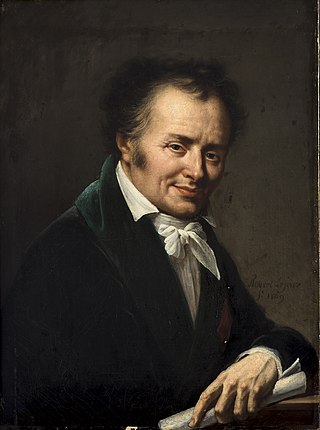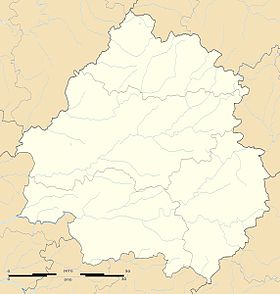
Dordogne is a large rural department in south west France, with its prefecture in Périgueux. Located in the Nouvelle-Aquitaine region roughly half-way between the Loire Valley and the Pyrenees, it is named after the river Dordogne, which runs through it. It corresponds roughly to the ancient county of Périgord. In January 2023, Dordogne had a population of 412,807.

The Académie royale de peinture et de sculpture was founded in 1648 in Paris, France. It was the premier art institution of France during the latter part of the Ancien Régime until it was abolished in 1793 during the French Revolution. It included most of the important painters and sculptors, maintained almost total control of teaching and exhibitions, and afforded its members preference in royal commissions.

Dominique Vivant, Baron Denon was a French artist, writer, diplomat, author, and archaeologist. Denon was a diplomat for France under Louis XV and Louis XVI. He was appointed as the first Director of the Louvre museum by Napoleon after the Egyptian campaign of 1798–1801, and is commemorated in the Denon Wing of the modern museum and in the Dominique-Vivant Denon Research Center. His two-volume Voyage dans la basse et la haute Egypte, 1802, was foundational for modern Egyptology.

Biron is a commune in the Dordogne department in southwestern France.

Bergerac is a subprefecture of the Dordogne department, in the region of Nouvelle-Aquitaine, Southwestern France. In 2018, the commune had a population of 26,823, which made it the department's second-most populated after the prefecture Périgueux. Located on the banks of the river Dordogne, Bergerac was designated a Town of Art and History by the Ministry of Culture in 2013.

Paul Maximilien Landowski was a French monument sculptor of Polish descent. His best-known work is Christ the Redeemer in Rio de Janeiro, Brazil.

The Château de Biron is a castle in the valley of the Lède in the commune of Biron in the Dordogne département of France.

Xavier Darcos is a French politician, scholar, civil servant and former Minister of Labour.

Igor Antić is a French-Serbian visual artist.
New European Painting emerged in the 1980s and reached a critical point of major distinction and influence in the 1990s with painters like Gerhard Richter, Sigmar Polke, Georg Baselitz, Anselm Kiefer and Bracha L. Ettinger whose paintings have established and continue to create a new dialogue between the historical archive, American Abstraction and figuration. The major new European painters of this era show strong engagements with painful personal and general history, as well as shared history; its memory and its oblivion; and with life under the shadow of World War II, utilizing research in new and old materials, photography and oil painting.

Félix-Alexandre Desruelles was a French sculptor who was born in Valenciennes in 1865. He was runner up for the Prix de Rome in 1891, won the Prix national des Salons in 1897 and a Gold Medal at l'Exposition Universelle in 1900. He died in La Flèche in 1943. He was a member of the Institut de France and of the Académie des Beaux-Arts.
Esther Shalev-Gerz is a contemporary artist. She lives and works in Paris.
Jan Kopp is a German visual artist. He has lived in France since 1991.
Jochen Gerz is a German conceptual artist who lived in France from 1966 to 2007. His work involves the relationship between art and life, history and memory, and deals with concepts such as culture, society, public space, participation and public authorship. After beginning his career in the literary field, Gerz has in the meantime explored various artistic disciplines and diverse media. Whether he works with text, photography, video, artist books, installation, performance, or on public authorship pieces and processes, at the heart of Gerz's practice is the search for an art form that can contribute to the res publica and to democracy. Gerz lives in Sneem, County Kerry, Ireland, since 2007.
Jean-Cyrille Rigaud was a French poet, playwright and doctor from Occitania.
Nadine-Josette Chaline is a contemporary French historian, specialist in religious history, especially Christians in France.

The Place de la République is one of the main squares of the city of Strasbourg, France. It is surrounded on three sides by five buildings only, of which none is residential: the Palais du Rhin, the National and University Library, the Théâtre national de Strasbourg, the Préfecture of Grand Est and Bas-Rhin, and the tax center Hôtel des impôts. All of these buildings are classified as monuments historiques. The fourth side of the square is devoid of buildings.

amaptocare is a large-scale public art work, in the form of a participative sponsored tree-planting project in Ballymun on the Northside of Dublin, Ireland. Proposed by German conceptual artist Jochen Gerz and commissioned by Breaking Ground on behalf of Dublin City Council's Ballymun Regeneration Limited as a percent for art scheme, it involved planting semi-mature trees in each neighbourhood of Ballymun, each with a personal comment from its sponsor inscribed on a nearby metal lectern. Over 630 trees from a choice of 15 mostly native varieties were sponsored, most by locals and other Dubliners, and 620 were planted by 2006.

Photo-text, also written as photo/text, is a hybrid form of artistic expression that combines photography and textual elements to convey a message or create a narrative. This combination allows for a multi-dimensional experience for the viewer.














